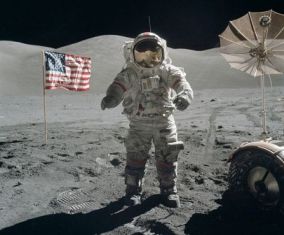Space Race in The Cold War
Learn the history of the Space Race during the Cold War. A race between the United States and the Soviet Union to put a man on the Moon.
What was the space race race in Cold War ?
The United States and the Soviet Union competed to have the best space technology during the Cold War. These featured contests to see who could launch the first manned spacecraft and who would set foot on the moon first. The Space Race was crucial because it revealed which nation had the best economy, science, and technology in the globe.

a person on the moon
The Race Begins
Both the United States and the Soviet Union knew after World War Two how crucial rocket research would be for the military. To aid in their study, they each enlisted the top German rocket scientists. Soon the development of rocket technology was being made by both sides.
When both nations said they would soon be putting satellites into space in 1955, the Space Race officially begun. The US declaration was seen as a challenge by the Soviets, who even formed a commission with the express purpose of outdoing the US in terms of launching satellites into orbit.
Soviet engineers successfully launched the first satellite into orbit on October 4, 1957. Sputnik I was the name of it. Throughout the Space Race, the Russians were in the lead. Four months later, the Explorer I, the first satellite launched by the US, was successful.
The First Man in Orbit
Once again, the Soviet Union won the race to launch the first human into space. In the spacecraft Vostok I, Yuri Gagarin became the first human to orbit the Earth on April 12, 1961. The US launched the Freedom 7 three weeks later, and astronaut Alan Shepherd became the first American in orbit. Yet, Shepherd’s craft did not orbit the planet. On February 20, 1962, over a year later, John Glenn, the first American in space, completed an orbit of the planet aboard the Friendship 7 spacecraft.
Race to the Moon
Being last in the Space Race embarrassed the Americans. Kennedy declared in front of congress in 1961 that he intended to be the first to land a man on the moon. For the nation and the western world, he considered this to be crucial. Launched was the Apollo Lunar program.
The Gemini Program
The US began the Gemini program in tandem with the Apollo program to develop technology for the Apollo spacecraft. The Gemini program taught Americans how to alter a spacecraft’s orbit, allowed them to spend a lot of time in space studying how the human body would be affected, brought two spacecraft together in a space rendezvous, and allowed them to take part in the first space walks outside of a spacecraft.
Man on the Moon
The Apollo 11 spacecraft was launched into space on July 16, 1969, following many years of tests, training, and experiments. Astronauts Michael Collins, Buzz Aldrin, and Neil Armstrong were on board. It took three days to travel to the Moon.
After arriving, Neil Armstrong and Buzz Aldrin transferred to the Eagle lunar module and started their lunar ascent. Armstrong had to manually land the module due to certain difficulties. The Eagle landed on the Moon on July 20, 1969. The first man to walk on the Moon was Neil Armstrong, who opened the door. Armstrong remarked, “That’s one modest stride for man, one great leap for mankind,” after taking his first step on the Moon.
The End of the Space Race
The US held a significant advantage in the Space Race thanks to the Gemini and Apollo programs. The Apollo-Soyez project featured the first US-Soviet collaborative mission in July 1975, when ties between the two countries were starting to warm. Effectively, the Space Race was done.
Facts About the Space Race in The Cold War
- As “sailors of the universe,” the Soviets referred to their astronauts as cosmonauts. The term “astronauts” was used to refer to the Americans.
- The Russians and Americans were discussing collaborating to send a man to the moon before Kennedy was slain. The Russians abandoned the collaborative project after he was slain.
- If they had been allowed to employ military rockets from the beginning, the US most likely would have launched the first satellite into orbit. Eisenhower was concerned, though, that if he deployed military rockets for space, people would accuse him of being a warmonger. He instructed the scientists to substitute research rockets.
- There weren’t many victories in the Space Race. Both sides had numerous setbacks, including collisions and explosions that claimed the lives of several astronauts.
Read also : Communism in cold war
 The First Encyclopedia Your First Knowledge Home
The First Encyclopedia Your First Knowledge Home
